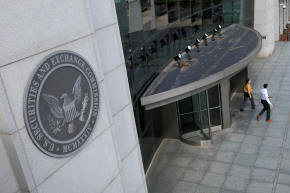U.S. money market funds say SEC draft rule would kill some products
 Send a link to a friend
Send a link to a friend
 [April 11, 2022] WASHINGTON
(Reuters) - U.S. asset managers are pushing back on draft rules aimed at
fixing systemic risks in the $5 trillion money market funds industry,
arguing that one of the proposed measures would kill off popular
products, executives told Reuters. [April 11, 2022] WASHINGTON
(Reuters) - U.S. asset managers are pushing back on draft rules aimed at
fixing systemic risks in the $5 trillion money market funds industry,
arguing that one of the proposed measures would kill off popular
products, executives told Reuters.
After taxpayers bailed out money market funds, a key source of
short-term corporate and municipal funding, for the second time in 12
years during the pandemic-induced turmoil of 2020, the industry is
facing renewed regulatory scrutiny.
Money market funds invest in high-quality short-term debt instruments
and offer daily redemptions. Investors expect immediate liquidity with
little price volatility and are spooked when those expectations are not
met during market stress.
As the pandemic shut down the economy in March 2020, investors pulled
more than $130 billion from some money market funds, contributing to
stress in the short-term funding markets, according to a Treasury
analysis that is disputed by the funds industry.
In December, the Securities and Exchange Commission (SEC) proposed
boosting money market funds' resilience by, among other measures,
adjusting a funds' value in line with trading activity so that redeeming
investors bear the costs of exiting a fund and don't dilute remaining
investors. In theory, this "swing pricing" reduces the incentive to run
to the exit first.

The deadline to submit comments is Monday and the industry is pushing
back hard on the swing pricing measures, arguing they would be
operationally challenging, impose excessive costs on fund sponsors, and
reduce daily liquidity for investors.
"We really do believe that it would kill the product," said Jane
Heinrichs, associate general counsel at the Investment Company
Institute, which represents the asset managers. "Funds would determine
it's not worth the changes necessary to make it work for a product that
will no longer meet the needs of investors."
The SEC has provided no data to support the idea, Heinrichs said.
While swing pricing is used by some European funds, it is an unfamiliar
concept to U.S. investors, said Peter Yi, a director at Northern Trust
Asset Management. "Without a doubt, swing pricing is going to be very
difficult for investors to understand."
An SEC spokesperson did not immediately provide comment.
[to top of second column] |

People exit the headquarters of the U.S. Securities and Exchange
Commission (SEC) in Washington, D.C., U.S., May 12, 2021.
REUTERS/Andrew Kelly/File Photo

To calm fleeing investors and stem a broader crisis, the Treasury and Federal
Reserve in March 2020 launched emergency liquidity facilities to backstop the
market. The panic was reminiscent of 2008, when a run on money market funds
likewise prompted the U.S. government to prop up the market.
That bailout led the SEC in 2010 and 2014 to introduce rules aimed at reducing
the risk of investor runs. But 2020 showed those changes were inadequate, said
regulatory experts.
Advocacy groups say money market funds are operating with an implicit government
guarantee, without the stringent capital and liquidity requirements such
guarantees usually require.
"The government is literally giving private business - the money market fund
sponsors - billions and billions a year for nothing," said Dennis Kelleher,
president of the Washington-based advocacy group Better Markets. "And then when
there’s market stress, they don't have to cover the downside."
His group is calling for wholesale reforms that go further than the SEC's
proposal, including bank-like capital buffers.
While the Investment Company Institute opposes swing pricing, it supports in
principle the SEC's proposal to raise funds' liquidity requirements, and to
allow fund boards more flexibility to charge for or suspend redemptions during
stress, known a fund "gate."
In 2020, investor runs accelerated as funds approached a minimum liquidity
threshold that, under the current rules, allows fund boards to gate redemptions.
The SEC rule would eliminate that bright line.
"By de-linking the fees and gates from the liquidity thresholds and increasing
the liquidity levels, you directly address the issues from 2020," Heinrichs
said.
(Reporting by Michelle Price; Editing by Leslie Adler)
[© 2022 Thomson Reuters. All rights
reserved.]This material may not be published,
broadcast, rewritten or redistributed.
Thompson Reuters is solely responsible for this content.
 |